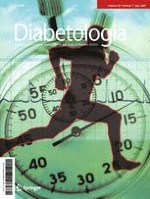Published in:

01-07-2007 | Article
Glucagon receptor antagonism improves islet function in mice with insulin resistance induced by a high-fat diet
Authors:
M. Sörhede Winzell, C. L. Brand, N. Wierup, U. G. Sidelmann, F. Sundler, E. Nishimura, B. Ahrén
Published in:
Diabetologia
|
Issue 7/2007
Login to get access
Abstract
Aims/hypothesis
Increased glucagon secretion predicts deterioration of glucose tolerance, and high glucagon levels contribute to hyperglycaemia in type 2 diabetes. Inhibition of glucagon action may therefore be a potential novel target to reduce hyperglycaemia. Here, we investigated whether chronic treatment with a glucagon receptor antagonist (GRA) improves islet dysfunction in female mice on a high-fat diet (HFD).
Materials and methods
After 8 weeks of HFD, mice were treated with a small molecule GRA (300 mg/kg, gavage once daily) for up to 30 days. Insulin secretion was studied after oral and intravenous administration of glucose and glucagon secretion after intravenous arginine. Islet morphology was examined and insulin secretion and glucose oxidation were measured in isolated islets.
Results
Fasting plasma glucose levels were reduced by GRA (6.0 ± 0.2 vs 7.4 ± 0.5 mmol/l; p = 0.017). The acute insulin response to intravenous glucose was augmented (1,300 ± 110 vs 790 ± 64 pmol/l; p < 0.001). The early insulin response to oral glucose was reduced in mice on HFD + GRA (1,890 ± 160 vs 3,040 ± 420 pmol/l; p = 0.012), but glucose excursions were improved. Intravenous arginine significantly increased the acute glucagon response (129 ± 12 vs 36 ± 6 ng/l in controls; p < 0.01), notably without affecting plasma glucose. GRA caused a modest increase in alpha cell mass, while beta cell mass was similar to that in mice on HFD + vehicle. Isolated islets displayed improved glucose-stimulated insulin secretion after GRA treatment (0.061 ± 0.007 vs 0.030 ± 0.004 pmol islet−1 h−1 at 16.7 mmol/l glucose; p < 0.001), without affecting islet glucose oxidation.
Conclusions/interpretation
Chronic glucagon receptor antagonism in HFD-fed mice improves islet sensitivity to glucose and increases insulin secretion, suggesting improvement of key defects underlying impaired glucose tolerance and type 2 diabetes.